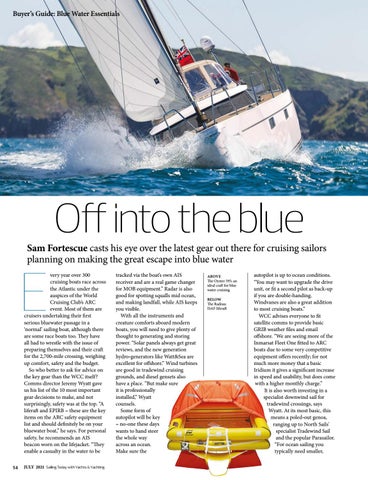Buyer’s Guide: Blue Water Essentials
Off into the blue
Sam Fortescue casts his eye over the latest gear out there for cruising sailors planning on making the great escape into blue water
E
very year over 300 cruising boats race across the Atlantic under the auspices of the World Cruising Club’s ARC event. Most of them are cruisers undertaking their first serious bluewater passage in a ‘normal’ sailing boat, although there are some race boats too. They have all had to wrestle with the issue of preparing themselves and their craft for the 2,700-mile crossing, weighing up comfort, safety and the budget. So who better to ask for advice on the key gear than the WCC itself? Comms director Jeremy Wyatt gave us his list of the 10 most important gear decisions to make, and not surprisingly, safety was at the top. “A liferaft and EPIRB – these are the key items on the ARC safety equipment list and should definitely be on your bluewater boat,” he says. For personal safety, he recommends an AIS beacon worn on the lifejacket. “They enable a casualty in the water to be
54
JULY 2021 Sailing Today with Yachts & Yachting
tracked via the boat’s own AIS receiver and are a real game changer for MOB equipment.” Radar is also good for spotting squalls mid ocean, and making landfall, while AIS keeps you visible. With all the instruments and creature comforts aboard modern boats, you will need to give plenty of thought to generating and storing power. “Solar panels always get great reviews, and the new generation hydro-generators like Watt&Sea are excellent for offshore.” Wind turbines are good in tradewind cruising grounds, and diesel gensets also have a place. “But make sure it is professionally installed,” Wyatt counsels. Some form of autopilot will be key – no-one these days wants to hand steer the whole way across an ocean. Make sure the
ABOVE The Oyster 595; an ideal craft for blue water cruising BELOW The Radeau ISAF liferaft
autopilot is up to ocean conditions. “You may want to upgrade the drive unit, or fit a second pilot as back-up if you are double-handing. Windvanes are also a great addition to most cruising boats.” WCC advises everyone to fit satellite comms to provide basic GRIB weather files and email offshore. “We are seeing more of the Inmarsat Fleet One fitted to ARC boats due to some very competitive equipment offers recently; for not much more money that a basic Iridium it gives a significant increase in speed and usability, but does come with a higher monthly charge.” It is also worth investing in a specialist downwind sail for tradewind crossings, says Wyatt. At its most basic, this means a poled-out genoa, ranging up to North Sails' specialist Tradewind Sail and the popular Parasailor. “For ocean sailing you typically need smaller,















